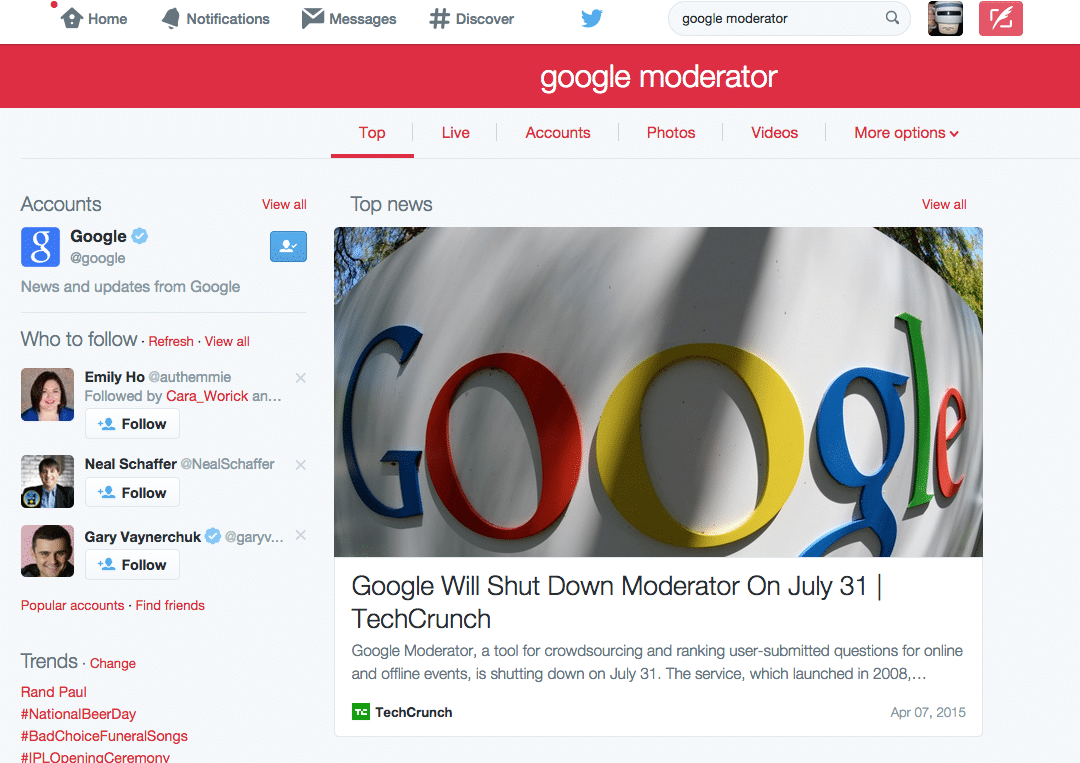Here’s what businesses should be thinking about
Do you expect to benefit from Google’s coming Twitter integration? Let us know in the comments.
In February, we learned that Google and Twitter made a new deal. This deal allows Google to index tweets in real-time. The tweets will show up in Google search results as soon as they are posted. Initially, we were told this would happen in the first half of this year. Now, we have a more specific timeline.

During a conference call about Twitter’s earnings, CEO Dick Costolo said the integration will begin next month. Since April is almost over, it could start as early as this week.
“I don’t have a specific date for you, but now I can at least give you a specific month,” said Costolo. “And that Google deal is all about…that relationship is about driving our total audience strategy. The goal is that people consume content and engage with that content whether they log in or not.”
Twitter Needs More Eyeballs
Twitter has struggled to grow its user base since it went public in 2013. Recently, it added 14 million users in one quarter, but it still only has about 300 million active users. For comparison, Facebook has 1.44 billion. Twitter is trying different ways to attract more users, especially those who are logged out.
This month, Twitter redesigned its homepage. For logged-in users, it’s still the usual home timeline. But for logged-out users, it’s a simple directory of content. Twitter has essentially turned its logged-out homepage into a news site.
The Google deal is a big opportunity for Twitter. It will help the company show more value to people who aren’t regular users. The importance of this deal is high for Twitter, especially since its stock prices have been disappointing.
Twitter and Google had a similar partnership in the past. However, the deal ended because the two companies couldn’t agree on terms.
Costolo explained, “The new Google deal lets us drive attention to logged-out users and the topics and events we want to highlight on Twitter’s front page.”
What’s Coming Next?
Not much is known about why the relationship between Twitter and Google fell apart before. The most likely reason is that Twitter thought it was worth more than Google was willing to pay. In the past, Google had a feature called Real-Time Search, which displayed a box of tweets and other content in search results for news-related queries. Once the deal ended, Google removed this feature, showing just how important tweets were for the company’s search engine.
Now, Google is likely to change how it uses tweets. Eric Enge, a search marketer, said Google may not change the user interface much. But, more tweets will likely get indexed. What’s most interesting is whether Google will use tweet data to personalize search results.
Enge said, “Google could prioritize content that people link to from tweets in future search results. This would be similar to how they treat Google+.”
We’ll have to wait and see if either company announces how the new integration will work. But, we may soon start seeing more tweets in search results.
How Google Uses Tweets Today
Earlier this year, Enge and his team analyzed over 133,000 tweets to see how Google indexes them. They found that only about 7.4% of tweets were indexed, meaning most tweets don’t appear in search results.
They discovered that tweets from accounts with larger followings are more likely to be indexed. However, Enge believes Google isn’t focusing on follower count but rather other signals like links to those accounts.
For instance, tweets from accounts with more than one million followers had 21% of their tweets indexed. For accounts with fewer followers, the percentage was lower.
The research also showed that tweets with images or hashtags are more likely to get indexed, while mentions of other accounts hurt the chances. Additionally, tweets with inbound links from other websites are much more likely to be indexed.
Enge said, “Google loves links. Tweets with inbound links are nearly four times more likely to get indexed than those without.”
Your reputation on the line?
Businesses should be aware that Twitter’s deal with Google could affect their reputation. Joshua March, CEO of Conversocial, said, “Every interaction on Twitter is now amplified. Complaints or issues with a company could show up on the front page of Google when someone searches for that business.”
If businesses have a social-first approach to customer service, they can quickly address these issues, turning negative interactions into positive ones. This deal could make it easier for customers to see how companies handle problems.
March added, “For businesses with great social customer service, this deal can shine a light on them, showing customers that they care.”
This goes beyond Google
Besides the Google deal, Twitter is also working with Apple. Costolo said, “We are collaborating with Apple to show Twitter content directly in Spotlight Search on iOS and OS X, making it easier for users to find great things on Twitter.”
Apple’s Spotlight Search is already showing Twitter content, and this could help Twitter get more attention.
Update: Apple’s spotlight search is reportedly already surfacing Twitter content.
Twitter clearly wants (and needs) to have its content surface as much as possible, so look for it to find other partnerships to fuel this as well.
Twitter is also experimenting with its search interface. The redesigned layout may help attract more users to Twitter search. Additionally, Twitter is indexing every public tweet from the last eight years.
Conclusion
Twitter’s deal with Google could change how tweets show up in search results. Businesses should keep in mind that any tweets related to their brand may become more visible. While the details are still unclear, this integration could have a big impact on online visibility and reputation.
Google’s Twitter Update Is About To Hit
- How to Monetize Your Facebook Page: A Comprehensive Guide - July 22, 2023
- Avoiding Plagiarism: Your Ticket to Originality and Academic Success! - July 21, 2023
- Chat-GPT: Your Friendly AI Pal for Awesome Conversations! - July 20, 2023


No Comments Yet